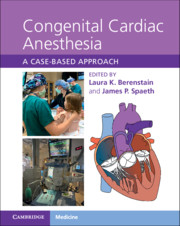Book contents
- Congenital Cardiac Anesthesia
- Congenital Cardiac Anesthesia
- Copyright page
- Dedication
- Contents
- Contributors
- Introduction
- Chapter 1 A Congenital Heart Disease Primer
- Section 1 Left-to-Right Shunts
- Section 2 Right-Sided Obstructive Lesions
- Section 3 Left-Sided Obstructive Lesions
- Section 4 Complex Mixing Lesions
- Section 5 Single-Ventricle Physiology
- Section 6 Heart Failure, Mechanical Circulatory Support, and Transplantation
- Chapter 31 Duchenne Muscular Dystrophy
- Chapter 32 Dilated Cardiomyopathy
- Chapter 33 Mixed Cardiomyopathy
- Chapter 34 Extracorporeal Membrane Oxygenation
- Chapter 35 Left Heart Ventricular Assist Device
- Chapter 36 Right Ventricular Assist Device
- Chapter 37 Lung Transplantation
- Chapter 38 Post Orthotopic Cardiac Transplantation
- Chapter 39 Failing Cardiac Transplant
- Section 7 Miscellaneous Lesions and Syndromes
- Index
- References
Chapter 33 - Mixed Cardiomyopathy
from Section 6 - Heart Failure, Mechanical Circulatory Support, and Transplantation
Published online by Cambridge University Press: 09 September 2021
- Congenital Cardiac Anesthesia
- Congenital Cardiac Anesthesia
- Copyright page
- Dedication
- Contents
- Contributors
- Introduction
- Chapter 1 A Congenital Heart Disease Primer
- Section 1 Left-to-Right Shunts
- Section 2 Right-Sided Obstructive Lesions
- Section 3 Left-Sided Obstructive Lesions
- Section 4 Complex Mixing Lesions
- Section 5 Single-Ventricle Physiology
- Section 6 Heart Failure, Mechanical Circulatory Support, and Transplantation
- Chapter 31 Duchenne Muscular Dystrophy
- Chapter 32 Dilated Cardiomyopathy
- Chapter 33 Mixed Cardiomyopathy
- Chapter 34 Extracorporeal Membrane Oxygenation
- Chapter 35 Left Heart Ventricular Assist Device
- Chapter 36 Right Ventricular Assist Device
- Chapter 37 Lung Transplantation
- Chapter 38 Post Orthotopic Cardiac Transplantation
- Chapter 39 Failing Cardiac Transplant
- Section 7 Miscellaneous Lesions and Syndromes
- Index
- References
Summary
The overall incidence of pediatric cardiomyopathy is estimated to be approximately 1–1.5 cases per 100,000 patients. The majority are due to dilated cardiomyopathy, which accounts for more than 50% of all cases. Hypertrophic cardiomyopathy is the second leading cause, with restrictive cardiomyopathy being the least common. While distinct classifications exist, in practice the variants occur in combination. However, there is generally a predominant phenotype diagnosed by echocardiography that allows for the formation of multicenter registries to track the epidemiologic, management, and outcomes related to pediatric cardiomyopathy. This chapter focuses on mixed hypertrophic and restrictive forms of cardiomyopathy and discusses the perioperative management of a patient with mixed cardiomyopathy.
Keywords
- Type
- Chapter
- Information
- Congenital Cardiac AnesthesiaA Case-based Approach, pp. 252 - 260Publisher: Cambridge University PressPrint publication year: 2021



